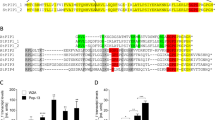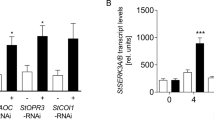Abstract.
The first responses in spruce [Picea abies (L.) Karst.] cells induced by elicitors (N-acetylglucosamine oligomers) from ectomycorrhizal fungi have been described as follows: efflux of Cl− and K+, influx of Ca2+, extracellular alkalinization, phosphorylation of a 63-kDa protein (pp63), dephosphorylation of a 65-kDa protein (pp65) and synthesis of H2O2 (Salzer et al. 1996, Planta 198: 118–126). In order to obtain new insights into the triggering mechanism and the sequence of these rapid responses we used compounds which are known to activate or block specific steps within an elicitor-induced signal transduction cascade in plant cells. Comparable to elicitors the two protein phosphatase inhibitors, cantharidin and calyculin A, as well as mastoparan, an activator of trimeric G-proteins, were able to induce the release of Cl− and K+ from spruce cells and the alkalinization of the medium. Half-maximal activation of the alkalinization occurred at 133 nM calyculin A, 2.3 μM cantharidin and 1.6 μ mastoparan. The structural analogue of mastoparan, Mas 17, which has no G-protein-stimulating properties, was unable to trigger the above-mentioned reactions. In addition, cantharidin and calyculin A induced an increased synthesis of H2O2 in spruce cells which was prolonged in comparison to the elicitor-induced transient formation of H2O2. Also, the cantharidin-induced release of K+ was more pronounced and longer lasting than that caused by elicitors from the ectomycorrhizal fungus Hebeloma crustuliniforme (Bull. ex Fries.) and N-acetylglucosamine oligomers. Furthermore, cantharidin, calyculin A and mastoparan induced the phosphorylation of pp63. Remarkably, the protein kinase inhibitor, staurosporine, inhibited all the rapid responses described above, no matter whether they were triggered by fungal elicitors or by the protein phosphatase inhibitors. These results indicate that in the initial signalling events in spruce cells, essential protein phosphorylations occur either as an (auto) phosphorylation of a membrane-bound receptor kinase prior to the activation of a G-protein or (and) immediately downstream of the activated G-protein in a phosphorylation cascade and are the basic requirements for the ion fluxes following downstream.
Similar content being viewed by others
Author information
Authors and Affiliations
Additional information
Received: 24 April 1998 / Accepted: 23 July 1998
Rights and permissions
About this article
Cite this article
Hebe, G., Hager, A. & Salzer, P. Initial signalling processes induced by elicitors of ectomycorrhiza-forming fungi in spruce cells can also be triggered by G-protein-activating mastoparan and protein phosphatase-inhibiting cantharidin. Planta 207, 418–425 (1999). https://doi.org/10.1007/s004250050500
Issue Date:
DOI: https://doi.org/10.1007/s004250050500




